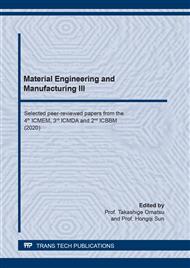p.15
p.25
p.31
p.37
p.43
p.49
p.54
p.63
p.69
Improvement of Poly(Lactic Acid) Properties by Ethylene-Octene Copolymer and Organoclay
Abstract:
The work studied the morphological, mechanical and thermal properties of poly(lactic acid) (PLA)/ethylene-octene copolymer (EOC) blends before and after adding the montmorillonite clay surface modified with 25-30% of octadecylamine (clay-ODA). The PLA/EOC blends and composites were prepared by melt mixing in an internal mixer. The EOC contents were 5, 10, 20, 30 wt% and clay-ODA contents were 1 and 3 phr. The morphology analysis showed that the addition of clay-ODA could improve the miscibility of PLA and EOC phases due to the domain size of dispersed EOC phase decreased with increasing clay-ODA content. X-ray diffraction revealed the formation of intercalated/exfoliated structure in PLA/clay-ODA and PLA blend composites. The mechanical properties showed that the impact strength of PLA/EOC blends dramatically increased with increasing EOC content up to 10 wt%. The strain at break of PLA blends increased with increasing EOC content. Moreover, the incorporation of clay-ODA increased significantly Young’s modulus of PLA and PLA/EOC blends with increasing clay-ODA content. The thermal stability of PLA/EOC blends improved with the addition of a small amount of clay-ODA.
Info:
Periodical:
Pages:
43-48
Citation:
Online since:
August 2020
Price:
Сopyright:
© 2020 Trans Tech Publications Ltd. All Rights Reserved
Share:
Citation:


